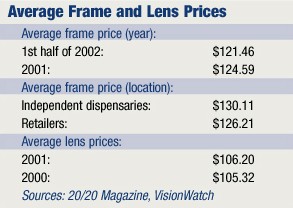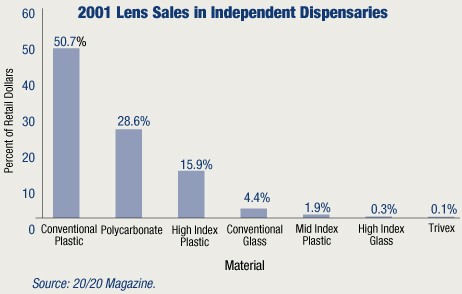Hows your optical dispensary doing? Well, if two of every three patients you examine get their glasses from you, youre just about meeting the national average (the rest either dont need glasses or get contact lenses). In other words, few spectacle scripts walk.
But 2002 has been a tough year for optical dispensaries all around. Independent dispensaries are coming off a year in which eyewear sales declined. Patients are waiting longer to update their eyeglass prescriptions. Of those who decide to take the plunge, theyre more likely to put new lenses in old frames. But, technological advances in lens materials and treatments are helping O.D.s stay ahead of this stormy economy.
The good news for O.D.s: 47.4 million people had eye exams in 2001, Jobson Optical Research shows. Of those, 88% purchased contact lenses or glasses, and more than two-thirds of them got their glasses where they got their exams. And, patients have more confidence in your advice than the recommendations of any other medical professional. First, though, you have to bring them into the office.
Where Butter Meets Bread
Sales for independent dispensaries overall declined from $5.2 billion in 2000, to $4.9 billion in 2001 (the last year for which statistics are available), Jobson Optical Research reports. That doesnt mean dispensers are doing less; theyre just getting less for it.
Across the United States, approximately 46.6 million people have regular eye exams each year, Jobson reports. Optometrists see about 27% of that population, ophthalmologists 26%, Jobsons Optical Industry Handbook (OIH) 2002 reports. (About 35% of respondents who had exams this year couldnt say who did them.) About 22% of those who had eye exams say they delayed the exam because they dont have a regular eye doctor.

Overall, chain retailers garner a small share of those prescriptions: 33% for chains vs. 67% for independents.
Most patients who come in for an exam leave with either eyeglasses or contact lenses. In the first half of 2002, 65% of patients who had exams bought a new pair of glasses, and 22% opted for contact lenses. If you consider that 57% of patients made their purchase at the location of their eye exam, thats even better news. The typical independent practitioner garners a little more than 60% of his or her gross from lens and frame sales.
Meanwhile, Jobsons OIH shows there are still some 9 million people in this country who need some sort of vision correction but dont have it. Thats about 180 patients for every eye doctor in the United States.
The competition for those potential patients is heating up. In 2001, 820 new retail outlets opened (2002 figures are not yet available), 20/20 magazines MarketPulse Premium Lens Survey reports. The chains didnt exactly benefit. Last year, chain retailers saw their overall sales decline slightly, to $5.4 billion. The big winners: the mass-merchandising discounters. They took in $9.7 billion in sales for 2001 vs. $9 billion in the year before.
Bundle Up, Doc
When it comes to specialty lenses and lens treatments, you and your colleagues continue to stay ahead of the curve. Scratch coating is the most popular lens treatment O.D.s dispense, having been added to 69% of optometric Rxes, the AOAs 2001 Optical Dispensing Survey results. Thats up six percentage points in three years. Job-sons OIH reports that more of you include scratch coating in the base price of the lens. That is, its not an option that patients pay extra for; its simply included in the reworked lens pricea concept known as bundling.
However, anti-reflective coating is a much tougher sell to patients. In Europe and Japan, AR graces 80% or more of the prescriptive eyewear dispenses, but in the United States it continues to lag around 20% Essilor Laboratories reports (though it has been growing steadily over the past few years).
Optometrists are doing their part to get the word out. About two-thirds of you recommend AR to all patients, our own Ophthalmic Product Research (OPR) survey shows. And, independent opticals do a better job than their corporate competitors in dispensing this treatment: 20/20s 2002 MarketPulse Lens Survey shows that close to 32% of the lenses dispensed in independent dispensaries in 2001 had AR.

Another treatment thats making it on to more lenses: UV coating. About 38% of all corrective lenses had this treatment in 2000, up about 12% from two years earlier, the AOA reports (2000 is the last year in which the survey was done).
Is this an area where youre missing an opportunity to educate your patients? Responses to our own OPR survey indicate that only 46% of O.D.s or staff currently routinely talk to patients about UV damage to the eyes; in 2000, 56% said they did so.
A national consumer survey by Transitions Optical Inc. reports that 79% of consumers are aware that UV rays have a harmful effect on the skin, but only 6% know about the possibility of UV damage to their eyes. Whats more, 20% of consumers do nothing to protect themselves from the sun, and even fewer (18%) wear sunglasses for this purpose. Most O.D.s say they also carry sunwear, which comprises about 11% of all lenses the typical practice dispenses.
Another source of prescriptions: specialized lenses for computer users. Most O.D.s (92%) who responded to our OPR survey do ask in the history if patients use computers, and 85% of O.D.s rank their knowledge of the vision problems computers can cause is good to excellent. Our survey also shows that close to 86% of doctors agree that a prescription change as small as 0.25D can make a significant difference to a computer users visual performance. And, 20/20s Market-Pulse survey reports that nearly 75% of independent dispensaries sold lenses specifically to increase patients intermediate to near zone while working at a computer.
Putting It Off
Now, about those patients who are putting off their eye care and eyewear: Slightly more than half of the consumer respondents to Jobsons OIH say they delayed the time of their latest eye exam because of cost. The rest say the cost of new glasses or contact lenses made them wait.
One way patients are dealing with the pinch in their pockets is by hanging on to old frames when their prescription changes. The average purchase time for a new frame increased from 2.56 years in 2000 to 2.69 years in 2001, 20/20 magazine says. And, 23% of patients who got new prescriptions in 2001 had new lenses fit into old frames, up from 21.5% in 2000.
Our own OPR survey indicates that doctors perceive that patients are less likely to be concerned about price as they are with aesthetics when choosing frames. Only 36% of O.D.s say price is the main reason a patient chooses a frame. Most (77%) say patients simply choose the frame that looks best, 72% say the design of the lens is most important, and 61% say comfort is paramount (totals equal more than 100% because more than one answer was allowed).
Jobsons VisionWatch reports the average price for a pair of frames during the first half of 2002 was $121.46. Thats down 2.5% from $124.59 in 2001. Both independents and retailers are a little above that mark though. Independent dispensaries averaged a frame price of $130.11, and retailers werent far behind at $126.21, VisionWatch reports. Mass merchandisers appealed to the low end of the market. Their average eyewear price is $79. (These data do not take into account the types of prescriptions filled, or if mass merchandisers fit a higher percentage of single-vision lenses vs. premium type lenses).

Lens prices are trending upward. The average price per pair was about $106.20 in 2001, up a little from $105.32 in 2000, 20/20 magazine reports. Over the past five years, retail lens prices have increased 11.3% and frame prices have jumped 8.8%. One reason lens prices are keeping pace with inflation is because of the increase in specialty designs, materials and treatments.
One of those designs contributing to this trend: progressive addition lenses. The increasing number of presbyopes helps, too. The average pair of PALs retailed for $210 in 2001, up only about 1% from the year before. PALs comprise about one in four of every lens pair independents dispense, 20/20 magazines MarketPulse survey shows. Nine of 10 O.D.s make PALs their first lens of choice for presbyopes, our own OPR reports.
If progressive Rxes go up, something must go down. That something is bifocals. Their share of the lens market dropped 20% between 1998 and 2000. Today, bifocals comprise about one in every five pairs of lenses independents dispense, 20/20 magazine reports.
Glass lenses, of course, are on the decline. This material comprises only 3% of all lens pairs independents prescribe, 20/20 magazine reports. Meanwhile, 58% of the lens pairs independents dispensed were plastic.
Polycarbonate is, of course, the rising star of the dispensing market, 20/20 reports that 29% of all lenses sold in 2001 were polycarbonate, up from 28% in 2000. Indepen-dents are dispensing polycarbonate at about the same rate, making 29% of their lenses in this material. And, 90% of O.D.s responding to our OPR make polycarbonate their first choice for childrens eyewear. (See 2001 Lens Sales in Indepen-dent Dispensaries below.)
Do It Yourself
Having an on-site lab allows O.D.s to turn around orders very quickly. Results of our OPR show only 41% of O.D.s have or share ownership in an optical laboratory. Three of every four optometrically controlled labs are finishing facilities only. And, eight of 10 such labs use patternless edgers. Typically, most (62%) O.D.s use their labs to process 26-50% of lens orders.
While it has taken a few years for most O.D.s to embrace patternless edgers, theyre taking to remote tracing equipment. Our OPR survey shows eight of 10 of all optom-etrists responding use this technology.
Theres good news and bad news when it comes to optometric dispensing this year. You re probably not seeing any more patients than in the past few years, but most of those who come in for exams get their eyewear from you. Of course, your next challenge is to bring in those patients who have been riding out the storm with their old Rxes.

